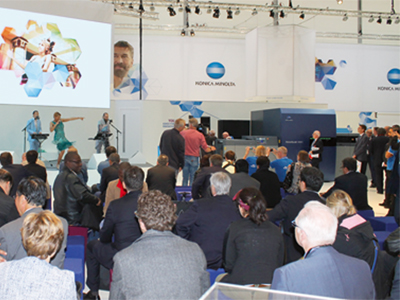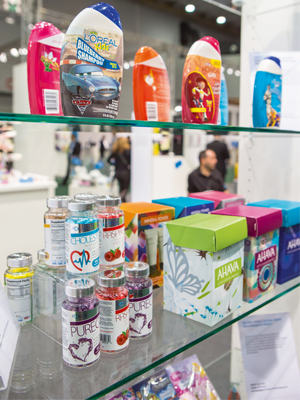Just as much as in analogue printing, digital inks need to be intimately suited to the print technologies and the applications for which they are designed. Michael Walker pries open the lids of various tins to see what’s inside.
As events at drupa 2016 will have underlined by the time you read this, the developers of digital print equipment see labels, and particularly packaging, as a huge growth area. Unlike commercial print, there is no electronic alternative – labels and packaging are not going away.
Digital print promises to let them move beyond the role of functional but stilted brand ambassadors. Mark Hinder, head of market development at Konica Minolta Europe, said, ‘Packaging can be a media asset; personalised packaging is the unification of marketing with packaging.’ Yogev Barak, director of business management at HP Indigo, concurred saying, ‘It’s a label but it’s also a communication vehicle, part of a broader marketing campaign.’
There are also more hard-headed financial reasons for liking digital, according to Rick Hulme, global sales and product manager at Sun Chemical, ‘Brands love the reduction in waste and the ability to do short runs; legislation and regional needs can mean that they may have to segment their production.’
So how far are we from brand nirvana? It depends which bit of the market you look at. ‘We’ve seen good development in single-pass printing in narrow web machines, with acceptance of the quality and speed that can be achieved,’ said Mr Hulme, though he pointed out that the speed expected in analogue print is of the order of 200 to 300 m/min and digital inkjet is still in the 50 to 70 m/min range.
If there is tolerance in some applications for lower speed from digital, there is less room for manoeuvre on quality. John Corrall, managing director of Industrial Inkjet (IIJ), commented, ‘Customers are seriously picky about quality, even looking under a microscope for defects a few microns in size.’
Ink different
A key factor in print quality and application flexibility is the ink. And just as there are different inks for analogue print technologies, such as offset, flexo or screen, so there is a growing variety of inks for digital print devices.
Digital inks used in labels and packaging can be broadly divided into three groups: water-based or UV-cured inkjet and liquid toners. Getting inks to perform in inkjet printheads is a challenge in itself. Agfa Graphics’ business development manager for industrial inks, Marc Graindourze, explained, ‘To get the ink to go through the nozzle, its viscosity has to be as much as 10,000 times lower than in an analogue ink. It has to be ‘tuned’ to be jettable with the right surface energy and surface tension characteristics, and it must contain fine particles with a very narrow size distribution – even one micron too large can block the nozzles.’ This limits the range of raw materials that can be used, and in the case of UV-curable inks, which Agfa focuses on for packaging applications, puts additional restrictions on the types of photoinitiators that can be included.
Water-based inks are seen as being more environmentally friendly, but often require pre-treatment of media – typically some kind of primer – to ensure adhesion without over-wetting and penetration of the substrate and to control drop behaviour before drying, adding to cost and complexity. Kodak’s director of digital materials at the firm’s enterprise injket systems division, Douglas Bugner, explained, ‘We keep the inks as simple and versatile as possible and use pre-treatment options to match to the various substrates.’ Kodak offers a range of ‘optimisers’ for use in its Prosper/Stream-based high speed inkjet systems which includes a newly introduced packaging version for use in corrugated systems, such as those being developed with Bobst, and a film variant for use with flexible packaging is in development.
There is a limit to how much pigment can be carried in water-based ink as it can potentially lead to clogging, which in turn puts an upper limit on colour density and saturation in single-pass printing applications. The exception here is perhaps the nanographic principle used in the Landa presses, which dries the water-based inkjet ink into a thin film on the transfer belt before transferring it to the substrate. The nano-particles are claimed to yield an increased colour gamut from a CMYK ink set.
EFI uses UV-cured inks in its Jetrion line of digital label presses and is switching to more efficient, longer-lived LEDs for curing. UV generally provides good durability and EFI’s Stephen Emery points to the UL (Underwriters Laboratory) certified labels for outdoor, industrial and nameplate applications that its Jetrion models can achieve. Landa also claims very good durability characteristics for its process, which like UV curing, results in a continuous film of ink being bonded to the substrate.
Sun Chemical’s AquaCure is a new hybrid that combines aspects of water’s environmental benefits and lack of odour with the adhesion, flexibility and maintenance/jet-ability of UV. Rick Hulme reports that the output looks very flat like analogue print, lacking the ‘build’ of typical UV-cured output.
All together now
There is pretty well no interchangeability between digital inks, even within a given print technology and application, as the three tend to be developed and fine-tuned as a complete solution that may extend beyond the print into finishing and be supported by dedicated workflow and pre-press options too, as in the case of Konica Minolta’s KM-1, now officially revealed as the AccurioJet.

New inks have been developed by Konica Minolta for the AccurioJet KM-1 (seen here at drupa) to avoid colour merging or overspraying issues
Konica Minolta has also developed its own ink type to avoid the colour merging or overspraying issues that it says can affect colour and image quality with UV-curable inks. The result is a paste that at room temperature is similar in consistency to peanut butter, but which becomes much more fluid when heated, enabling very uniform drops to be ejected. According to KM’s Mark Hinder, these cool as they travel through the air to the substrate so that they don’t spread when they land, allowing ‘incredibly fine’ detail to be imaged and very precise colour control for a Delta E variance of 1.5 which is all but undetectable to most viewers. While the AccurioJet is aimed at B2 commercial print applications, the company has also developed the KM-C, a flatbed B1 machine aimed at carton and thin corrugated production on substrates up to 1.2 mm thick. It is assumed that this uses the same new ink.
The liquid toner technology that is of most immediate interest to the packaging community is HP’s ElectroInk used in the well-established Indigo range; the other is Xeikon’s Tonnik, used in the new Trillium press, although the initial model is firmly aimed at direct mail and catalogue publishing. Xeikon has no stated plans for this technology in packaging, currently offering a Folding Carton Suite based on its proven dry toner technology, though Tonnik would seem highly applicable to cartons and potentially corrugated too.

HP ElectroInk is used by the Indigo range of presses for labels and packaging
HP Indigo has introduced Pack Ready materials for high performance flexible packaging applications, which do away with flexible laminate adhesive curing processes, as the ElectroInk is immediately dry. Indigo presses can also print a wide variety of label types and offer up to seven colour stations. In addition to standard CMYK, orange, violet and green inks are offered, plus white for flexible packaging applications; custom colours can be produced on request. A ‘one shot’ transfer process allows all the colour layers to be laid down at once on heat-sensitive flexible media.
HP also addresses the corrugated packaging sector with two product families, the PageWide web presses and the HP Scitex flatbed wide format inkjets. PageWide uses water-based inks for pre-printing of liners for production runs up to the tens of thousands; the HP Scitex line allows direct to board printing with UV-cured inks, but is aimed more at display/PoS material and limited run bespoke packaging.
Good enough to eat?
Food packaging is another area that digital vendors are eyeing hungrily, although achieving the necessary low migration performance via inkjet is difficult, as the characteristics that give the necessary low viscosity also tend to allow more migration. Most digital packaging solutions are only suitable for non-contact applications in food packaging, such as sleeves or cartons, especially where UV-curable inks are concerned. Water-based inks can be suitable, however, and IIJ has been testing latex ink types for use in food contact applications, though John Corrall reported that adhesion is an issue. Sun Chemical has several years’ experience here. ‘Low migration became a fashionable statement but the understanding wasn’t necessarily there,’ recalled Rick Hulme. ‘It’s not just a case of putting the right ink in, it’s about how the machine, the media and the environment need to be compliant.’
Agfa too has had success in digital printing on food packaging, via partnerships with bottling systems supplier KHS, printing directly onto PET beverage bottles, with Polytype for print onto cups and tubs, and with Sacmi for print onto plastic closure caps. It is clear that there is a tremendous rate of development in digital printing technology for packaging. While increasing production speeds is more the province of printhead, workflow software and media transport engineering, the breadth of applications and quality achievable remain largely in the domain of ink development and here too, the innovation continues to flow.






